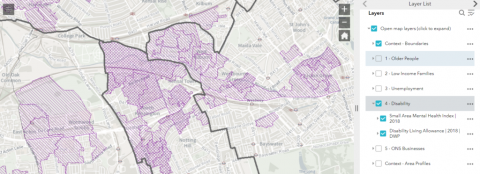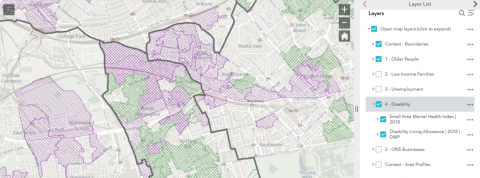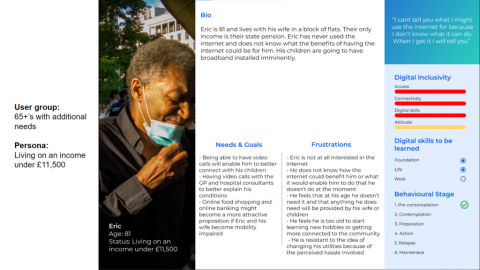LOTI Project: cross-borough digital inclusion
Skip to:
About the LOTI Project
The project set out to tackle digital exclusion by creating an interactive map that highlights all aspects of the issue, with the aim of driving collaboration and more tailored initiatives.
Digital exclusion is when people are not capable of using or benefiting from the internet.
There are many barriers that can cause digital exclusion meaning that people lack digital skills or connectivity, or have accessibility requirements that are not being fulfilled.
The research showed that giving a laptop or tablet to someone without one is not enough to tackle digital exclusion. We must design support focused on a person's needs and specific situation.
The project produced a digital exclusion map and persona pack which together help to design the right interventions in the places where they are needed.
This project was done in collaboration with the five boroughs of Westminster, Kensington and Chelsea, Brent, Barnet and Southwark.
Our research
This project produced a number of resources aimed at supporting other local authorities wanting to tackle digital exclusion.
- View the digital exclusion map
- View the persona pack
- View the full research summary
- View the toolkit
Aims of the project
The aims of the LOTI project were to:
- get a better understanding of the extent of digital exclusion and how the issues is evolving using data sets and persona analysis
- map the softer aspects of digital exclusion and gather data on the structural and behavioural aspects that cause this
- build a toolkit for digital exclusion mapping
- understand the impact of digital support provided during the COVID-19 pandemic through interviews.
Key takeaways and insights
Insights from the map
The map we developed is designed to help digital inclusion leads, voluntary and community sector organisations and others to understand the geographic distribution of digital exclusion down to ward level.
Access the digital exclusion map here.
Identify key groups
The map includes open data sets to identify high concentrations of people at risk of being digitally excluded.
This is based on five key groups identified through initial research completed at Westminster and validated across the other boroughs. They include:
- older people
- low income families
- unemployed
- those with a disability
- small and micro businesses
Using the map, you can begin to see which areas that are more at risk of digital exclusion.
In the example below, you can see wards in North Kensington that have a higher proportion of both people with a disability and older people.
In these areas, you might want to consider how multiple needs intersect. The digital inclusion persona pack (see below) explains how you can centre your interventions on user needs.
Combining with local data
More can be learned by combining the mapped data sets with local data.
Follow the instructions in the digital exclusion mapping toolkit for details on how to access the open data on the 5 key groups as GeoPackages and geodatabases and for our full methodology.
Access the digital exclusion mapping toolkit
For example, Westminster has combined open data on the key groups with commercial data (Acorn Data set) and the Low Incomes Families Tracker (LIFT) to provide a more granular analysis.
Accessing this data
Due to the sensitivity of this type of analysis, they are not for publication and a Data Privacy Impact Assessment (DPIA) should be completed before carrying out any personally identifiable analysis.
Understanding the user personas
Personas are archetypes designed to represent the types of digital exclusion barriers someone might face. They are a tool for designing services based on user needs.
The pack of 24 personas helps you to understand the needs, experiences and factors leading to digital exclusion from a person-centred perspective.
They are based on research carried out and validated across the five borough partners.
Boroughs may want to carry out a validation exercise in their own area using the guidance and templates in the toolkit.
Using the personas
Personas can be used alongside insights from the map to help design support and interventions.
For example, if you have identified an area with a larger than average deprived older people you could use the personas of Eric, Mary and Harold to inform your service design.
Combining the map and personas enables you to design the right intervention in the places where they are needed (also known as place-based intervention).
Insights from qualitative and quantitative research
To gain a deeper understanding of the nuances of digital exclusion, face-to-face surveys were undertaken with 850 residents across Westminster and Kensington and Chelsea and 16 interviews lasting 1 hour were conducted with residents from Barnet, Brent and Southwark.
This data highlighted that simply creating a supply of devices and data will not be enough for many people who are currently digitally excluded.
Projects need to be designed around the interest of those in your key groups, not around the digital service you may want them to engage with.
Quantitative insights into digital exclusion
The most significant barriers identified included lack of interest, confidence and skills.
The quantitative analysis highlighted that:
- 64% of non-internet users said they have no interest in using the internet and that nothing would persuade them
- just 1 in 10 non-internet users said a free device would most likely encourage them to use the internet in the future
- across the top four key groups, social activities were the most important perceived benefit of accessing the internet
- unemployed respondents were more likely than average to access the internet in a library, community centre or public place
- 40% of respondents said they'd prefer to receive help from friends and family to improve their confidence and skills, but more than 9 in 10 (91%) had no children living in their household
Qualitative insights into digital exclusion
In the interviews, participants told us that:
- digital support allowed participants to stay in touch with peers, significantly improving behaviour, mental wellbeing, confidence and comfortability with digital activities
- it can be challenging to learn how to use a new device, especially keyboards with lots of letters and symbols which can confuse or distract participants
- most participants discovered digital support via a support worker or a teacher and did not always recognise what digital support means
- there wasn't a full understanding of what digital skills training could lead to, such as what career progression after an Excel course could look like
These insights suggest the following service considerations should be taken into account:
- digital support can provide respite alongside usual provision such as day centres
- a tablet with a touch screen may be more intuitive than a keyboard or mouse
- consider comprehensive device onboarding support for caregivers, such as where they can report technical issues or internet safety concerns
- keep track of users in the context of career planning or personal goals, such as thinking about whether beneficiaries could be upskilled to be digital trainers themselves
Funding the project
The project has been funded as part of the London Office of Technology and Innovation's (LOTI) COVID Innovation Fund.
The Greater London Authority have brought their geographic information system, data and demography expertise to build the pan-London map on the London Datastore.
The five boroughs of Westminster, Kensington and Chelsea, Brent, Barnet and Southwark put forward a successful bid, winning £75,000 to work collaboratively on a data solution to develop a better understanding of digital exclusion across London.
The project ran from February to July 2021.
Further information
Full data from the survey and additional information on the methodology will be made available as part of the Mapping Digital Exclusion Toolkit.
If you would like further information or have any questions, please contact the Insight and Intelligence Hub at Barnet Council via email: insightandintelligencehub@barnet.gov.uk



